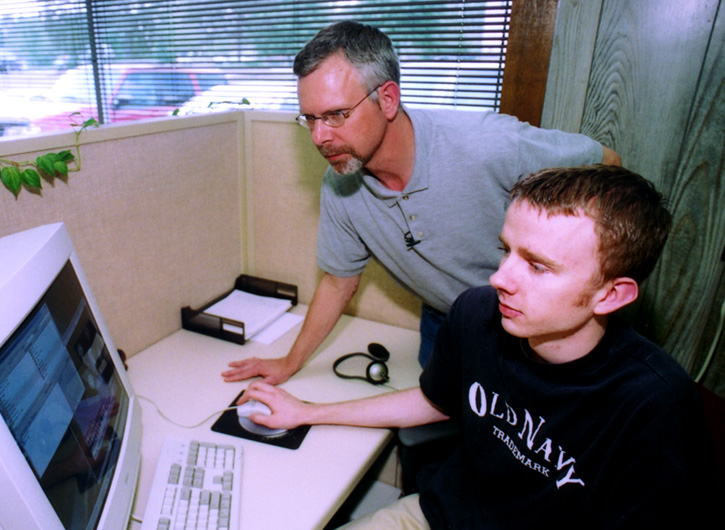Contact: Phil Hearn

MSU senior research associate Scott Calhoun (standing) and computer science major Matthew Bennet of New Albany
Researchers at Mississippi State are working with the U.S. Army Corps of Engineers to develop a computer-friendly guide aimed at protecting U.S. military installations around the globe from increasing terror threats.
The Joint Anti-Terrorism/Force Protection task force is working with the SENTEL Corp. and MSU's Center for Educational and Training Technology to produce an antiterrorism program management guide for use by all five military service branches. Col. Jerry Love of the Army Engineer Research and Development Center in Vicksburg is JAT director.
Created in 1996 and led by Dan Brook and Richard Koshel, the Center for Educational and Training Technology develops innovative software tools through an interdisciplinary approach involving a wide cross section of students and faculty.
"We face an enemy that is difficult to define," said Love. "Our intelligence is imperfect and we are required to make estimates and assess risks in the planning process. The JAT Guide is an integrated decision-making process to help the commander and his AT staff focus scarce resources in a programmatic approach to continuously provide a successful installation defense against terrorist attack."
Corps plans for the guide already were on the drawing board at the time of the 9/11 terrorist assaults on the World Trade Center and the Pentagon. After the attacks, however, the Defense Department quickly allocated $10 million to develop the guide over a three-year period.
Alexandria, Va.-based SENTEL, known for its innovative research and development services, was brought in as the project's prime subcontractor.
Through a long-standing professional connection with Mississippi State associate research vice president Donald Trotter, Love turned to the technology training center, which now is housed in a university building on Russell Street in Starkville. Senior CETT research associate J. Scott Calhoun was asked to develop a computer Web site for the JAT guide, along with the software for deploying the guide and designing various training applications.
Since January 2002, Mississippi State has received three DoD grants totaling nearly $640,000 to set up an anti-terrorism guide demonstration, develop a beta version of an anti-terrorism program manager's guide Web portal and complete training applications.
"We are developing a Web site that will walk people through the functions of building the plan," explained Calhoun, a Wichita, Kan., native and 1988 MSU master's degree graduate in electrical engineering. "The Web site will be placed in a secure network that will not be accessible to the public."
Assisting Calhoun are research associates Debra T. Brown and Allan Bullwinkel, artist Jennifer Brou, and sophomore computer science major Matthew Bennett of New Albany.
Using drop-down menus, packaged tools and databases, and pre-designed, product-oriented templates, the PC-based program could be distributed to commanders on a compact disk. The Secret Internet Protocol Router Network (SIPRNET) will be utilized to install upgrades and update patches from the Defense Technical Information Center.
Calhoun said the guide will be used by U.S. military officers around the world to plan against potential terrorist threats to fixed installations, troops undergoing deployment and expeditionary forces. The guide also can be applied to protect other potential targets such as dams, electric power plants and water supplies, he added.
"It could apply to any asset threatened by terrorism," he said.
Assembly of an anti-terrorism staff, commander input, mission analysis, threat assessment, determination of critical assets, impact on surrounding community and measurement of potential morale problems stemming from a terrorist act are among a wide variety of considerations that must be incorporated into the JAT Guide, Calhoun said.
"Whether it's a warehouse full of munitions or a building full of people, you have to value each of those assets in terms of your base mission," he said. "It's a very complex process."
The Vicksburg-based Engineer Research and Development Center, which combines all Corps of Engineers R&D operations into one organization, conducts research for corps civil works and military projects. It also assists other federal agencies, state and municipal authorities, and American industry through innovative work agreements.
NEWS EDITORS/DIRECTORS: For more information, contact Calhoun at (662) 325-9397 or jscott@cett.msstate.edu.